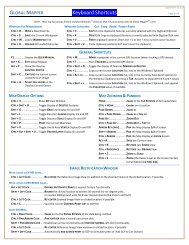Map GPS Coordinates - GPS Map Coordinates ... - Global Mapper
Map GPS Coordinates - GPS Map Coordinates ... - Global Mapper
Map GPS Coordinates - GPS Map Coordinates ... - Global Mapper
Create successful ePaper yourself
Turn your PDF publications into a flip-book with our unique Google optimized e-Paper software.
e useful for aviation purposes.<br />
<strong>Global</strong> <strong>Map</strong>per User's Manual<br />
Optionally, you can also specify that the receiver elevation should be calculated based on an elevation<br />
angle relative to the horizon from the transmitter. This is useful if you have something like a radar<br />
dish that points up at some angle and you want to see where the signal can be seen.<br />
Finally, you can also specify a transmission angle range for a beam transmitted from the transmitter.<br />
Then the view shed will depict where that beam would hit the terrain surface (or some user-specified<br />
distance above the surface).<br />
The Select Elevation Layer(s) to Base Transmitter/Receiver Heights On button displays a dialog<br />
allowing you to select which of the loaded elevation layers you want to base ground-relative<br />
transmitter and receiver heights on. The default is to use all loaded layers, but if you have a situation<br />
where you have a ground level data set loaded and perhaps another set with heights of buildings, etc.,<br />
you could use this option to cause the transmitter and receiver heights to be based on the ground<br />
elevation, whereas the actual visibility of each point will use the topmost of any loaded layer.<br />
The View Radius section allows the user to specify how far in each direction from the transmitter to<br />
check for visibility. Typically you'd want to set this to the effective range of your transmitter. If you<br />
want to ignore areas close to the transmitter, you can also specify a minimum view radius value. Use<br />
the default of 0 to include everything from the transmitter out ot the selected view radius.<br />
The View Angle section allows the user to limit the view shed to a particular subsection of the<br />
complete radial area. The Start Angle specifies the cartographic angle at which the radial subregion<br />
begins. This angle is a cartographic angle, meaning that 0 degrees is north and angles increase<br />
clockwise. The Swept Angle specifies the number of degrees clockwise to include in the view shed.<br />
For example, if the transmitter being analyzed sweeps an arc from due south to due west, a start angle<br />
of 180 with a swept angle of 90 would be used. To perform a view shed analysis over the entire area,<br />
keep the defaults of starting at 0 degrees and sweeping through 360 degrees.<br />
The Earth Curvature section allows the user to specify whether they want to take the curvature of the<br />
earth into account while performing the view shed analysis. In addition, when earth curvature is being<br />
used, they can specify an atmospheric correction value to be used. The atmospheric correction value<br />
is useful when determining the view shed for transmitting waves whose path is affected by the<br />
atmosphere. For example, when modeling microwave transmissions a value of 1.333 is typically used<br />
to emulate how microwaves are refracted by the atmosphere.<br />
The Sample Spacing section allows the user to specify the spacing of elevation samples when<br />
calculating the view shed. The sample spacing controls the interval at which elevation samples are<br />
examined to determine visibility. Smaller values result in more accurate, but more slowly generated,<br />
view sheds.<br />
The Fresnel Zone Specification section allows you to have the view shed analysis also check that a<br />
certain portion (the Percent Clear value) of the first Fresnel zone for a transmission of a particular<br />
frequency is clear. The typical standard is that good visibility requires that at least 60% (the default)<br />
of the first Fresnel zone for the specified frequency be clear of obstructions. If you specify a<br />
maximum Fresnel zone percentage clear other than 100%, only those locations where the minimum<br />
percentage of the 1st Fresnel zone that is clear is between your specified percentages will be marked<br />
as visible.<br />
<strong>Map</strong> <strong>GPS</strong> <strong>Coordinates</strong> - <strong>GPS</strong> <strong>Map</strong> <strong>Coordinates</strong> - <strong>GPS</strong><strong>Coordinates</strong> <strong>Map</strong> 170







